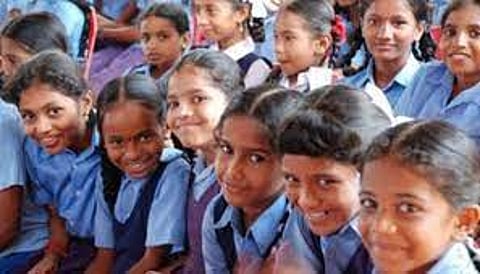
New Delhi - In India, there has been a longstanding connection between caste and education, with Brahmins historically seen as the rightful custodians of knowledge. Unfortunately, individuals from lower castes, such as Sudras and Dalits, have often been marginalized, depicted as inferior and unworthy of education.
This discrimination has persisted through generations, resulting in many modern-day Dalit children being the first in their families to attend school. However, despite some progress in school enrollment rates, Dalit children still face significant obstacles to education, including poverty, social discrimination, and caste-based prejudice.
According to an analysis by the National Campaign on Dalit Human Rights, while there has been an increase in overall enrollment of Scheduled Caste (SC) and Scheduled Tribe (ST) students from 2001 to 2011, a considerable number drop out before completing their education.
By upper primary and secondary levels, dropout rates among SC and ST children are alarmingly high. A 2014 survey by the International Market Research Bureau (IMRB) highlighted that Scheduled Caste children remain the most vulnerable group in terms of school dropout rates, followed by Scheduled Tribe and minority children.
Despite efforts to improve school enrollment and reduce dropout rates nationwide, the challenges faced by Scheduled Caste children emphasize the ongoing prevalence of caste-based discrimination in education.
The pervasive influence of patriarchy in education extends beyond surface appearances, with a prevailing belief that investing in a girl's education is futile compared to prioritizing her skills for household duties. Conversely, educating boys is often seen as securing the family's future and elevating its legacy. This mindset transcends class and caste boundaries.
According to a UN Chronicle article on gender disparity in primary education in India, regions in the south and west generally exhibit better rates of girl child education compared to the north and east. Government initiatives such as 'Sarva Shiksha Abhiyan' and 'Beti Bachao, Beti Padhao Abhiyan' aim to promote girl child education through various incentives, including free scholarships and schemes like 'Kanyashree Prakalpa' in West Bengal and free bicycles for girls in Haryana.
Despite these efforts, caste dynamics significantly influence the expectations and interactions of Scheduled Caste (SC) and Scheduled Tribe (ST) children, particularly girls, making them more susceptible to dropping out of school. During adolescence, girls face heightened challenges, including inadequate sanitation facilities in rural schools, leading to increased dropout rates. This lack of access to reproductive health education further exacerbates their vulnerability, often resulting in early marriage and involvement in manual labour, mirroring the circumstances of their parents.
Economic hardship compels boys from impoverished families to abandon their education and seek employment, often migrating to cities for low-wage labour. Among Dalit communities, young men below 18 are disproportionately affected, forced to prioritize work over education, sometimes engaging in menial jobs like scavenging or sewage work before and after school, which significantly disrupts their studies.
In August of 2023, tragedy struck when 9-year-old Dalit student, Indra Meghwal, lost his life after being brutally beaten by his school principal for the simple act of drinking water from a pot designated for upper-caste individuals. This horrific incident sheds light on the inhuman treatment Dalit children endure in educational institutions.
According to the National Campaign on Dalit Human Rights (NCDHR), women employed as garbage collectors in the Pune Municipality have expressed deep concerns about their children facing discrimination in private schools. In these institutions, children of sanitation workers often encounter systematic discrimination, including inadequate attention and substandard teaching quality, ultimately leading to demotion and eventual dropout as they are compelled to seek refuge in government schools.
Despite the Right to Education (RTE) Act's mandate of 25% reservation for economically weaker sections (EWS), there remains a significant underrepresentation of Scheduled Tribes (ST), Scheduled Castes (SC), and girls due to financial constraints. This disparity underscores the urgent need for comprehensive reforms to ensure equitable access to quality education for all children, irrespective of their socio-economic background or caste identity.
The Ambedkar Centre for Action and Research (ACAR) conducted a comprehensive study on schools catering to the children of sanitation workers in Maharashtra, uncovering significant disparities and challenges faced by these marginalized communities.
While some schools exist in Pune, Nagpur, and Mumbai specifically catering to these children, several remain closed in parts of the state. These schools, such as the "Safai Kamgaranchi Shaskiya School Middle School Pune," often bear names that reflect the occupation of the students' parents, contrasting sharply with other schools across the country.
As a result, some children feel reluctant to disclose the name of their school due to the prevalent caste-based discrimination and the fear of social exclusion.
ACAR's study, focused primarily on municipal corporation schools in Pune, highlighted that a staggering 90-95% of students come from economically weaker sections, with only a small 5% representing middle-class families. Of particular concern is the frequent absence of adolescent girls, especially from the Vadar Community, during menstruation due to inadequate facilities and societal taboos surrounding menstruation.
Furthermore, the study revealed that 50% of students drop out after completing the 7th standard, citing various factors such as the distance to government schools and the increasing financial burden of education. Many adolescents are compelled to seek employment in garages and workshops upon leaving school, underscoring the pressing need for comprehensive support and interventions to address these systemic challenges faced by marginalized communities in accessing quality education.
Also Read-
You can also join our WhatsApp group to get premium and selected news of The Mooknayak on WhatsApp. Click here to join the WhatsApp group.